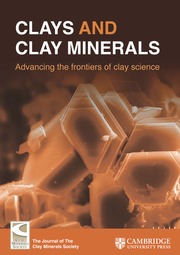Crossref Citations
This article has been cited by the following publications. This list is generated based on data provided by
Crossref.
Ruiz Cruz, María Dolores
and
Franco, Francisco
2000.
Thermal Decomposition of a Dickite-Hydrazine Intercalation Complex.
Clays and Clay Minerals,
Vol. 48,
Issue. 5,
p.
586.
Johnston, Cliff T.
Bish, David L.
Eckert, Juergen
and
Brown, Lori A.
2000.
Infrared and Inelastic Neutron Scattering Study of the 1.03- and 0.95-nm Kaolinite−Hydrazine Intercalation Complexes.
The Journal of Physical Chemistry B,
Vol. 104,
Issue. 33,
p.
8080.
Kristóf, János
Frost, Ray L.
Martens, Wayde N.
and
Horváth, Erzsébet
2002.
Separation of Adsorbed and Intercalated Hydrazine in Hydrazine-Hydrate Intercalated Kaolinite by Controlled-Rate Thermal Analysis.
Langmuir,
Vol. 18,
Issue. 4,
p.
1244.
Franco, F.
and
Ruiz Cruz, M. D.
2002.
High-Temperature X-Ray Diffraction, Differential Thermal Analysis and Thermogravimetry of the Kaolinite-Dimethylsulfoxide Intercalation Complex.
Clays and Clay Minerals,
Vol. 50,
Issue. 1,
p.
47.
Deng, Youjun
Dixon, Joe B.
and
White, G.Norman
2003.
Molecular configurations and orientations of hydrazine between structural layers of kaolinite.
Journal of Colloid and Interface Science,
Vol. 257,
Issue. 2,
p.
208.
Franco, F.
and
Ruiz Cruz, M. D.
2003.
Thermal behaviour of dickite-dimethylsulfoxide intercalation complex.
Journal of Thermal Analysis and Calorimetry,
Vol. 73,
Issue. 1,
p.
151.
Onal, Y.
Yakıncı, E.
Seçkin, T.
and
Içduygu, M.G.
2005.
Synthesis and characterization of asbestos–silane hybrid materials.
Colloids and Surfaces A: Physicochemical and Engineering Aspects,
Vol. 255,
Issue. 1-3,
p.
27.
Horváth, Erzsébet
Kristóf, János
and
Frost, Ray L.
2010.
Vibrational Spectroscopy of Intercalated Kaolinites. Part I..
Applied Spectroscopy Reviews,
Vol. 45,
Issue. 2,
p.
130.
Cheng, Hongfei
Liu, Qinfu
Yang, Jing
Zhang, Qian
and
Frost, Ray L.
2010.
Thermal behavior and decomposition of kaolinite–potassium acetate intercalation composite.
Thermochimica Acta,
Vol. 503-504,
Issue. ,
p.
16.
Johnston, C. T.
2010.
Probing the nanoscale architecture of clay minerals.
Clay Minerals,
Vol. 45,
Issue. 3,
p.
245.
Xu, Hongliang
Wang, Meng
Liu, Qinfu
Chen, Deliang
Wang, Hailong
Yang, Kaijun
Lu, Hongxia
Zhang, Rui
and
Guan, Shaokang
2011.
Stability of the compounds obtained by intercalating potassium acetate molecules into kaolinite from coal measures.
Journal of Physics and Chemistry of Solids,
Vol. 72,
Issue. 1,
p.
24.
Zhang, Yinmin
Liu, Qinfu
Wu, Zeguang
Zheng, Qiming
and
Cheng, Hongfei
2012.
Thermal behavior analysis of kaolinite–dimethylsulfoxide intercalation complex.
Journal of Thermal Analysis and Calorimetry,
Vol. 110,
Issue. 3,
p.
1167.
Caglar, Bulent
2012.
Structural characterization of kaolinite-nicotinamide intercalation composite.
Journal of Molecular Structure,
Vol. 1020,
Issue. ,
p.
48.
Cheng, Hongfei
Liu, Qinfu
Yang, Jing
Ma, Songjiang
and
Frost, Ray L.
2012.
The thermal behavior of kaolinite intercalation complexes-A review.
Thermochimica Acta,
Vol. 545,
Issue. ,
p.
1.
Caglar, Bulent
Çırak, Çağrı
Tabak, Ahmet
Afsin, Beytullah
and
Eren, Erdal
2013.
Covalent grafting of pyridine-2-methanol into kaolinite layers.
Journal of Molecular Structure,
Vol. 1032,
Issue. ,
p.
12.
Zhang, Shuai
Liu, Qinfu
Cheng, Hongfei
Li, Xiaoguang
Zeng, Fangui
and
Frost, Ray L.
2014.
Intercalation of dodecylamine into kaolinite and its layering structure investigated by molecular dynamics simulation.
Journal of Colloid and Interface Science,
Vol. 430,
Issue. ,
p.
345.
Tippayasam, Chayanee
Keawpapasson, Pimpawee
Thavorniti, Parjaree
Panyathanmaporn, Thammarat
Leonelli, Cristina
and
Chaysuwan, Duangrudee
2014.
Effect of Thai Kaolin on properties of agricultural ash blended geopolymers.
Construction and Building Materials,
Vol. 53,
Issue. ,
p.
455.
Liu, Qinfu
Zhang, Shuai
Cheng, Hongfei
Wang, Ding
Li, Xiaoguang
Hou, Xinjuan
and
Frost, Ray L.
2014.
Thermal behavior of kaolinite–urea intercalation complex and molecular dynamics simulation for urea molecule orientation.
Journal of Thermal Analysis and Calorimetry,
Vol. 117,
Issue. 1,
p.
189.
Cheng, Hongfei
Xu, Peijie
Wang, Ding
and
Frost, Ray L.
2016.
Thermal decomposition behavior and de-intercalation kinetics of kaolinite/quaternary ammonium salt complexes.
Journal of Thermal Analysis and Calorimetry,
Vol. 126,
Issue. 2,
p.
421.
Cheng, Hongfei
Liu, Qinghe
Xu, Peijie
and
Hao, Riwa
2018.
A comparison of molecular structure and de-intercalation kinetics of kaolinite/quaternary ammonium salt and alkylamine intercalation compounds.
Journal of Solid State Chemistry,
Vol. 268,
Issue. ,
p.
36.

